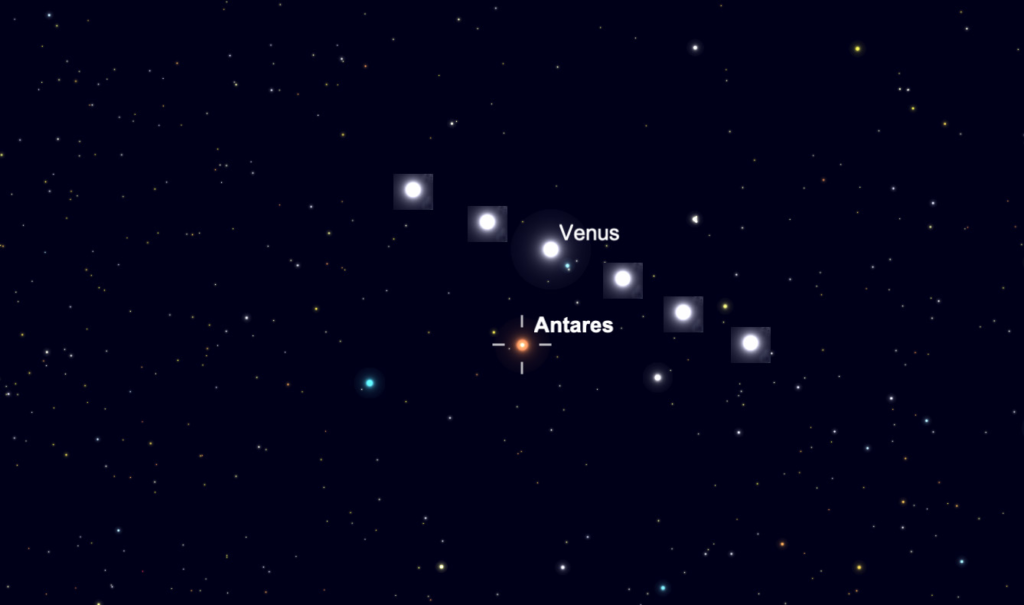Sky Report: October 11 – October 17, 2021

Venus passing Antares on the 13th through 18th.
Graphic created with SkySafariAstronomy.com.
Three of the four bright planets are easy to spot in the evening sky, and in order of appearance they’re Venus, Jupiter, and Saturn. Mars is behind the sun and cannot be seen.
Venus appears first because it’s the brightest, and in fact it’s so bright you can see it during the daytime with your eyes alone if you know precisely where to look (and that’s the trick). It’s surprisingly easy to see at the moment of sunset, and here’s how to do it: find it early one night, perhaps using binoculars, and mark its position with reference to the horizon and its height. Look for it a bit to the left of that position 15 or so minutes earlier the next night, and repeat, until you can see it at sunset – and before. Binoculars are a huge help.
Venus’ brilliance comes largely from its highly reflective clouds. Notice how pure white is its light, which is reflected sunlight. Compare this to the color of the red star Antares which Venus passes on Saturday the 16th. Antares is a red giant star and one of the largest stars you can see (Google it). Antares is the brightest star in Scorpius and the 15th brightest star in the entire sky, but Venus is 140 times brighter. On the 16th Antares is 1½°, or three times the diameter of the moon, below Venus, although the two remain close all week. Take the opportunity to watch Venus approach and then pass Antares night by night; a conjunction is a process, not an event, so don’t look on just the 16th. This is the closest Venus will come to Antares until October 2029.
The second planet to appear is Jupiter, which is almost as bright as Venus but which is seen against a darker background sky, farther from the sun. Look for it a third of the way up the southeastern sky as darkness falls. It’s far brighter than any star, so you can’t miss it.
Saturn is 1/20 as bright as Jupiter, which puts it as bright as the brightest stars, and it’s 15° to the upper right of Jupiter. Remember that the width of your fist held at arm’s length is about 10°. The “waxing gibbous” moon is near Saturn on the 13th and roughly between Jupiter and Saturn on the 14th.
Under a grant from the Utah Governor’s Office of Economic Development and the Kane County Office of Tourism, Stellar Vista Observatory offers portable telescopes and tripod mounted binocular kits on loan for free to all residents of Kane County. Nothing beats a quality binocular or astronomical telescope to enhance enjoyment of the night sky! Visit https://stellarvistaobservatory.org/discover-the-night-sky/ for full details.
The Sky Report is presented as a public service by the Stellar Vista Observatory, a nonprofit organization based in Kanab, Utah, which provides opportunities for people to observe, appreciate, and comprehend our starry night sky. Additional information is at www.stellarvistaobservatory.org. Send questions and comments to
John@StargazingAdventures.org.






Comments are closed.